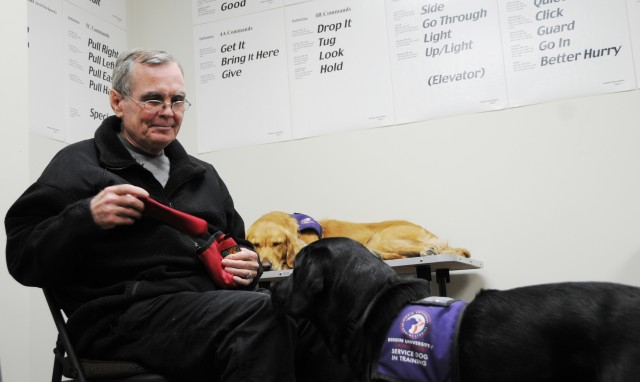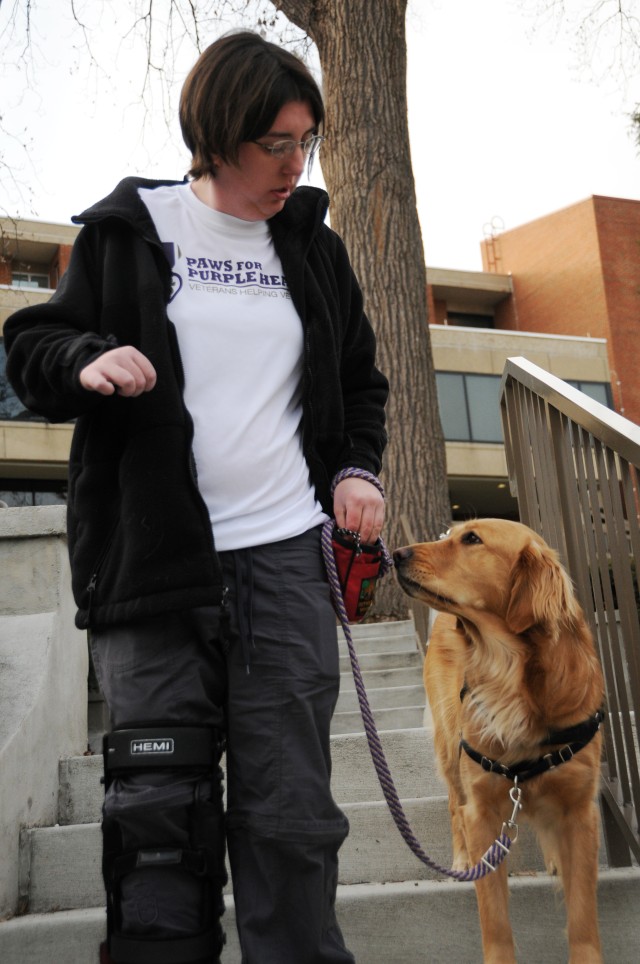WASHINGTON (Army News Service, Feb. 8, 2011) -- Paws for Purple Hearts, a non-profit that teaches wounded Soldiers to train service dogs for seriously-disabled veterans, may soon begin testing the physiological reactions that come from working with the animals.
Soldiers returning from Iraq and Afghanistan often suffer from non-physical wounds such as post-traumatic stress disorder and traumatic brain injury, commonly referred to as TBI, which are disorders the organization believes it is helping alleviate.
In partnership with the National Intrepid Center for Excellence, program founder Rick Yount hopes that studies on how man's best friend helps servicemembers will confirm what he already believes -- that training dogs saves lives.
"We have powerful anecdotal evidence, more than one veteran saying 'this dog saved my life,' but now we'd like to find out why this works," said Yount.
Testing planned at National Intrepid Center for Excellence for this fall will focus on sleep studies, tracking biomarkers and symptom reduction, with the goal of providing viable statistics on the benefits of PTSD patients working with service dogs, Yount explained.
One in five servicemembers who deployed is estimated to suffer from PTSD, according to a 2008 Rand study, a topic that has become an increasing concern to Army and government leaders.
Yount, a social worker for 24 years, explained the idea for Paws for Purple Hearts came to him one day while watching the news. In 2006, Yount had already been working as a service dog trainer at Bergin University in California, and while watching the increasing reports about servicemembers returning from deployments with PTSD and TBI, he realized they would be excellent service dog trainers.
"It sounds so simple," Yount said of his organization's comprehensive approach. "But there's nothing wrong with simple answers to difficult problems."
The program was started at the Veterans Affairs Health Care System's Menlo Park in Palo Alto, Calif., in 2008, the program has now also branched out to Walter Reed Army Medical Center in Washington, D.C. At Walter Reed, the program is located adjacent to the Warrior Transition Battalion, so Soldiers recovering there can easily access and inquire about the program.
Soldiers in the Warrior Transition Battalion must participate in a "work in education" program, where, as able, they are required to pursue an interest or activity non-related to their physical recovery to prepare them for life after the hospital.
The Soldiers have the choice to pick among different "internships" and Paws for Purple Hearts is one of them.
However, what started as a service to severely-wounded veterans has turned in some cases into a comprehensive treatment for PTSD, Yount explained.
"It's not for everybody, but it seems to work on the people who are struggling the most," Yount said of the program.
Yount said servicemembers have attributed training service dogs to saving their lives, marriages, and parenting abilities.
He said one Soldier who had insomnia requiring heavy sleeping medication, slept six hours straight the first night he took one of the dogs home with him. Another Soldier told Yount the program saved his marriage because prior to working with the dogs, he was treating his 3 year old like a private.
"Learning to train this dog taught me how to give praise and how to connect with my 3 year old," Yount said the Soldier told him.
The dogs also force the Soldiers to interact with other people and to engage in possible symptom-producing situations.
"There's no way you can isolate when you have a service dog and you're training in the community," Yount said. "People are going to come up to you and interact with you, there's no way out of it."
Yount explained that some of the characteristics of PTSD include emotional numbness, isolation, insomnia, hyper-vigilance and nervousness in crowds. Yet Soldiers training dogs have to challenge their symptoms in order to be successful: they have to get in touch with their emotions to give praise, and guide the dogs through crowds, ensuring them that it's safe.
In essence, servicemembers with PTSD have to do the exact opposite of what they are feeling to complete their mission: to train a dog for a fellow vet. It's a deeply-ingrained sense of duty that pushes them, Yount said, and in turn, many end up healing themselves.
"I've spent almost 30 years in the military and there's a reason for it," said Chief Warrant Officer Francis Young, who first joined the Army in 1976. "It's a way of life that's a brotherhood. I'd like to give back."
The helicopter pilot began working with Paws for Purple Hearts about a year ago after he was sent to Walter Reed for neck surgery.
"I find it very therapeutic," Young said. "I've always been around animals, and grew up with them and I enjoy working with the dogs."
Young explained that he'll be seeking a service dog himself to help him with balance after he's discharged, and added that he'd like to see more Soldiers participating in the program.
"There's a lot of dogs that are needed, so the more people you have to train them, the more service dogs there will be," said Young.
Yount said that the program has done much better than he first expected, and he hopes to expand the program to five more Veterans Affairs locations in the future, pending a congressional vote on funding.
He said he's thankful for the interest others have shown, and that without financial contributions, Paws for Purple Hearts would "just be another idea in a filing cabinet."
Related Links:
STAND-TO!: Mild Traumatic Brain Injury Research






Social Sharing